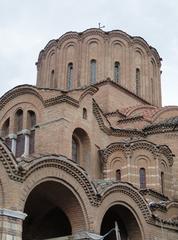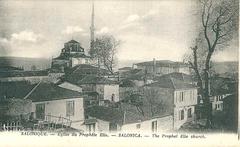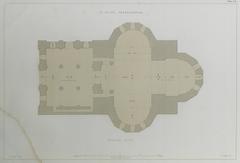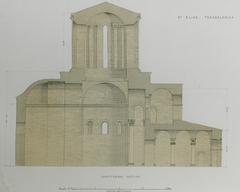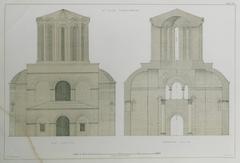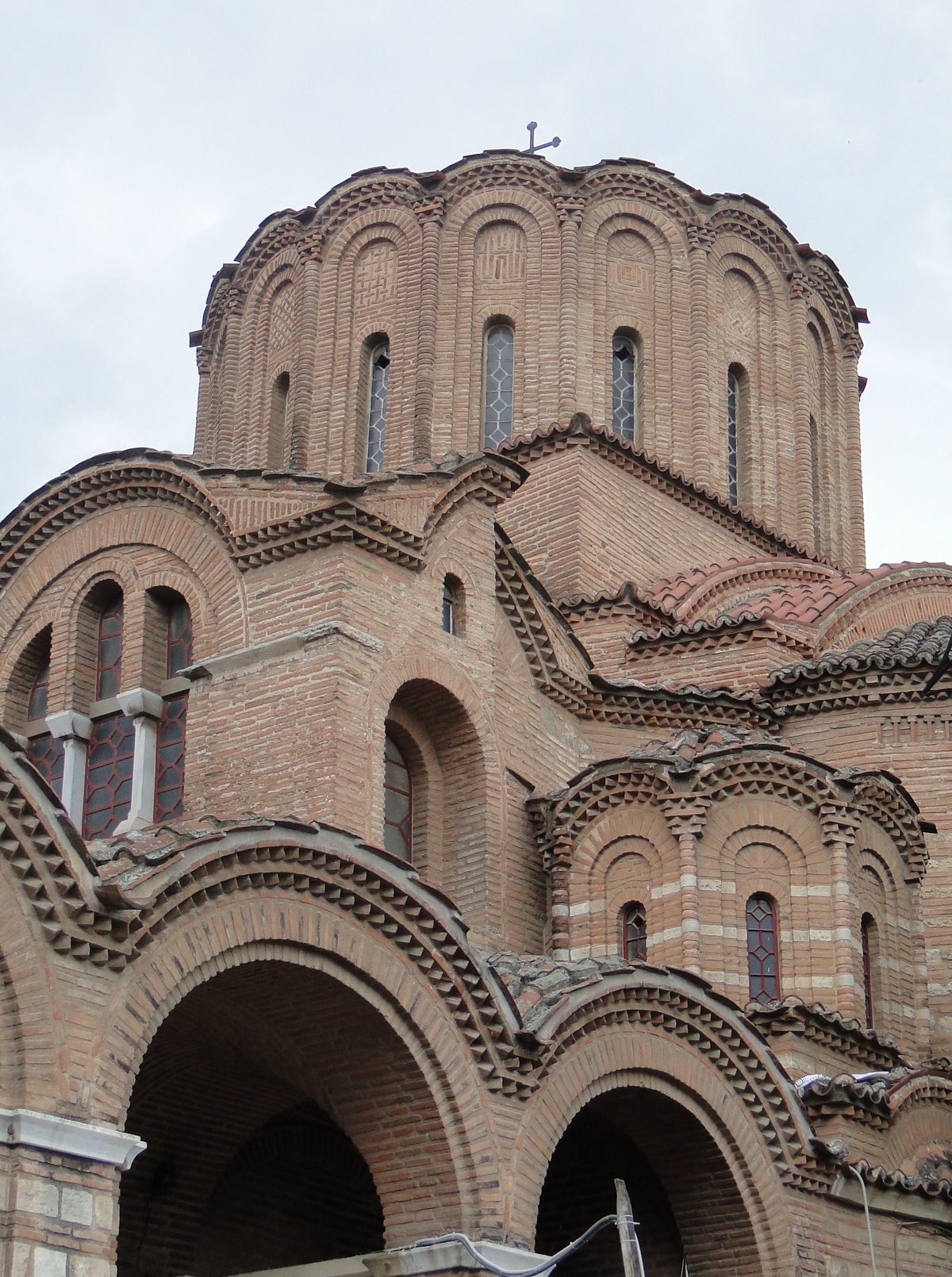
Church of Prophet Elijah Thessaloniki: Visiting Hours, Tickets & Historical Sites Guide
Date: 14/06/2025
Introduction
The Church of Prophet Elijah (Profitis Ilias) in Thessaloniki is a masterpiece of late Byzantine architecture and a living witness to the city’s religious, artistic, and cultural transformations. Built in the 14th century, it is Thessaloniki’s only surviving example of the Athonite cross-in-square monastic church type, renowned for its soaring domes, intricate masonry, and evocative frescoes. Over the centuries, it has served as a monastic katholikon, an Ottoman mosque, and, today, a vibrant Orthodox place of worship, earning its place among the UNESCO-listed Paleochristian and Byzantine Monuments of Thessaloniki. This guide provides a comprehensive overview of the church’s history, architectural highlights, practical visitor information—including opening hours, ticket details, accessibility, and nearby attractions—and tips for making the most of your visit. For detailed resources and up-to-date information, consult the Thessaloniki Tourism Organization, the official UNESCO listing (UNESCO World Heritage), and tools like the Audiala app (Visit Greece).
Table of Contents
- Overview & Significance
- Historical Background
- Architectural Features
- Artistic & Religious Importance
- Ottoman Transformation & Modern Restoration
- UNESCO World Heritage Status
- Practical Visitor Information
- Visitor Tips & Suggested Itineraries
- Frequently Asked Questions (FAQ)
- Conclusion & Call to Action
- Sources & Further Reading
Overview & Significance
Nestled in Thessaloniki’s picturesque Upper Town (Ano Poli), the Church of Prophet Elijah offers a rare insight into the city’s Byzantine heritage. Its unique Athonite design, rare for urban churches, reflects both the monastic traditions of Mount Athos and the artistic renaissance of the Palaiologan period. The church’s layered history—from its debated monastic origins, through centuries as Saraylı Mosque under Ottoman rule, to its current Christian dedication—mirrors the city’s own complex past (The Byzantine Legacy; UNESCO World Heritage).
Historical Background
Construction and Early Use
Built between 1360 and 1370, the church was likely the katholikon (main church) of a major monastery, possibly Akapniou or Nea Moni (Visit Greece; The Byzantine Legacy). Its original dedication was probably to Christ, as suggested by the iconographic program in the narthex, but its current dedication to Prophet Elijah results from later misinterpretation of the Ottoman-era name “Saraylı Mosque” (Wikipedia).
Ottoman Era and Restoration
After the Ottoman conquest in 1430, the church was converted into the Saraylı Mosque by Badrah Mustafa Pasha. Christian frescoes were covered or destroyed, and Islamic features such as a mihrab and minaret (now lost) were added. The building returned to Christian worship following Thessaloniki’s liberation in 1912, with restoration efforts gradually unveiling its Byzantine artistry (Religious Greece; Visit Central Macedonia).
Architectural Features
Athonite Cross-in-Square Design
The church is Thessaloniki’s only example of the Athonite “tetrastyle cross-in-square” plan, a form developed for monastic churches on Mount Athos (The Byzantine Legacy). Its main features include:
- Central dome supported by four columns, creating a luminous worship space.
- Tripartite sanctuary with three apses at the east end.
- Narthex and exonarthex at the west, enabling processions and gatherings.
- Triconch plan with large north and south conches, nearly equal in size to the sanctuary conch.
Masonry and Decorative Details
The exterior displays alternating layers of red brick and white ashlar stone, echoing Constantinopolitan styles. Decorative brickwork, ceramic disks, and blind arcading provide rhythm and color to the façade (ArchNet).
Light and Atmosphere
Windows in the dome and conches allow sunlight to illuminate key architectural elements, fostering a sense of divine presence and reinforcing the church’s spiritual ambiance.
Interior Frescoes and Iconography
Though many frescoes suffered during the Ottoman era, surviving fragments in the narthex and nave exemplify the refined artistry of the Palaiologan Renaissance. Scenes from the Life of Christ, the Virgin, and individual saints remain, offering insight into 14th-century iconography (Religious Greece; Wikipedia).
Artistic & Religious Importance
Monastic and Liturgical Role
Originally serving a monastic community, the church’s spacious design facilitated Byzantine liturgies and processions. The narthex (“liti”) allowed for gatherings and ritual movements, while the elevated location symbolized spiritual ascent (Visit Central Macedonia).
Feast Day and Living Heritage
The church celebrates its feast on July 20th, drawing local worshippers and visitors to its vibrant liturgical and cultural festivities (Thessaloniki Tourism).
Ottoman Transformation & Modern Restoration
During Ottoman rule, the church’s Christian imagery was plastered over, a mihrab was installed, and a minaret was likely constructed. Despite these changes, the core Byzantine structure survived. Restoration in the 20th century focused on revealing original features and conserving surviving frescoes (Visit Greece).
UNESCO World Heritage Status
The Church of Prophet Elijah is one of 15 Paleochristian and Byzantine Monuments of Thessaloniki inscribed on the UNESCO World Heritage List since 1988. This status recognizes its architectural, artistic, and historical value as a vital link in Thessaloniki’s Christian and Byzantine legacy (UNESCO World Heritage).
Practical Visitor Information
Visiting Hours & Tickets
- Usual Hours: 8:30 AM–2:00 PM daily. Hours may vary seasonally or during holidays. Check current times with the Thessaloniki Tourism Organization or on site.
- Tickets: Admission is typically free. Donations are welcome to support ongoing preservation.
Accessibility
- The church is located in Ano Poli, accessible by steep, cobbled streets; suitable footwear is recommended.
- Accessibility for visitors with mobility issues is limited due to uneven terrain and lack of modern features.
Tours & Audio Guides
- Guided tours are available via local agencies and cultural organizations.
- The Audiala app provides an in-depth audio guide for self-directed exploration (Visit Greece).
Photography
- Photography without flash is permitted. Always respect posted guidelines and avoid disrupting services.
Dress Code & Etiquette
- Modest attire is required (shoulders and knees covered).
- Maintain silence and respect during services; refrain from flash photography.
How to Get There & Nearby Attractions
- Location: Ano Poli (Upper Town), easily reachable on foot or by taxi from the city center.
- Nearby: Vlatadon Monastery, Church of Hosios David, Byzantine Walls, and traditional tavernas.
Visitor Tips & Suggested Itineraries
- Allow 30–45 minutes for your visit.
- Combine with a walking tour of Ano Poli’s Byzantine landmarks.
- Visit during spring or autumn for pleasant weather and fewer crowds.
- Check for special events or liturgical feasts (notably July 20th).
- Visit early in the day to avoid closing time and enjoy a quieter experience.
Frequently Asked Questions (FAQ)
Q: What are the visiting hours of the Church of Prophet Elijah?
A: Generally 8:30 AM–2:00 PM daily, but check for seasonal variations.
Q: Is there an entrance fee?
A: No; entrance is free. Donations are appreciated.
Q: Is the church accessible for visitors with disabilities?
A: Accessibility is limited due to cobblestone streets and steps.
Q: Can I take photos inside?
A: Yes, without flash. Look for posted signs.
Q: Are guided tours available?
A: Yes, through local operators and with the Audiala app.
Q: When is the church’s feast day?
A: July 20th, with special liturgical celebrations.
Conclusion & Call to Action
The Church of Prophet Elijah is a highlight of Thessaloniki’s Byzantine and religious heritage, offering visitors a rare blend of architectural grandeur, spiritual ambiance, and layered history. Plan your visit to immerse yourself in the city’s past, and complement your experience with guided tours or audio guides for deeper context. For current information and more historical sites, consult official tourism resources and download the Audiala app.
Visuals & Maps
Insert images: “Church of Prophet Elijah Thessaloniki exterior view,” “14th-century frescoes inside Church of Prophet Elijah.”
Embed interactive map of Thessaloniki highlighting the church and nearby monuments.
Internal Links
Sources & Further Reading
- Church of Prophet Elijah in Thessaloniki: History, Architecture & Visitor Guide, 2025 (Visit Greece)
- Church of Prophet Elijah Thessaloniki: Visiting Hours, Tickets & Architectural Highlights, 2025 (UNESCO World Heritage)
- Visiting the Church of Prophet Elijah in Thessaloniki: History, Architecture, and Visitor Information, 2025 (Thessaloniki Tourism)
- Church of Prophet Elijah Thessaloniki: Visiting Hours, Tickets & Historical Sites Guide, 2025 (Spotting History)
- The Byzantine Legacy, 2025 (The Byzantine Legacy)
- Religious Greece, 2025 (Religious Greece)
